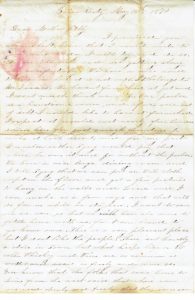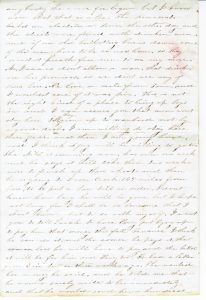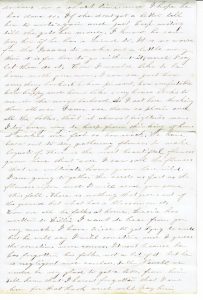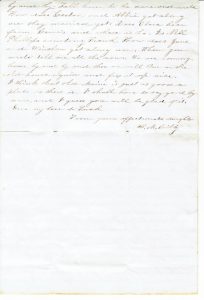
The bins of my family memorabilia (my “squirrel bins”) occasionally allow a real gem or two to escape, those things I hope to find but which seldom surface: diaries, journals, or letters.
One such gem is a faded, handwritten letter dated Boise City, May 15, 1870. Written by Hannah (Brown) Libby to “Dear Mother Libby,” it is a poignant expression of homesickness while trying to maintain a positive outlook, an offer of more questions to be answered than answers given. I was intrigued, especially because this Hannah and “Mother Libby” are two faceless women in my long lineage. I have no photo of either woman, no other correspondence, writings, or stories.
After some searching through census records, Bible records, and family photos, I found that Hannah Brown married William Tyng Libby (“Tyng”) in November 1853, and with the birth of daughter Felicia in 1854 she would become my great-great-grandmother.
 Writing to her mother-in-law, Hannah shows she was a woman of strong opinions: “This is a very pleasant place but I don’t like the people. There isn’t hardly a store in town but what keeps liquor to sell. Whiskey and wine are as common as water and used as freely and more so. You know that the folks that came home to Maine from the west said that where rum was used openly and freely that they never saw anybody the worse for liquor but I know that to be a lie. The democrats held an election in town the other day and the streets were filled with drunken men, and if one old building burns down some of the men have to be carried home, so they needn’t preach free rum to me any more.” There’d be no hootch in her lemonade nor politicians in her parlor!
Writing to her mother-in-law, Hannah shows she was a woman of strong opinions: “This is a very pleasant place but I don’t like the people. There isn’t hardly a store in town but what keeps liquor to sell. Whiskey and wine are as common as water and used as freely and more so. You know that the folks that came home to Maine from the west said that where rum was used openly and freely that they never saw anybody the worse for liquor but I know that to be a lie. The democrats held an election in town the other day and the streets were filled with drunken men, and if one old building burns down some of the men have to be carried home, so they needn’t preach free rum to me any more.” There’d be no hootch in her lemonade nor politicians in her parlor!
 She also makes it clear in her letter that Tyng owes money to more than one person and is slow to send the money; she promises to send the money she owes to Newell for a book. She states that she makes do without a house or furniture of her own in order to save money, pay off debts, and have more to take home with them. I wonder if that ever happened; neither Hannah nor Tyng sound like good money managers.
She also makes it clear in her letter that Tyng owes money to more than one person and is slow to send the money; she promises to send the money she owes to Newell for a book. She states that she makes do without a house or furniture of her own in order to save money, pay off debts, and have more to take home with them. I wonder if that ever happened; neither Hannah nor Tyng sound like good money managers.
The last page of her letter, however, shows a woman who is desperately homesick: “How I would like to be home with you now. I can see just how every thing looks. Oh, how pleasant, how comfortable, how happy and home like every house looks to me in the neighborhood. As I set here thinking them all over I can see them so plain and all the folks, that it almost frightens me. I try every way to keep from thinking of home it makes me feel so homesick.” Hungry for home, she pleads for news and gossip of her friends and family.
 Hannah did manage to go home again, but not to stay. In 1880 she was living with her mother Sarah (Reed) Brown and younger brother Enoch Brown in her hometown of Vassalboro, Maine, while husband Tyng worked in mills in California. These family nomads moved again before 1890 to join their daughter Felicia in Kansas, where Tyng died in 1893. Hannah spent her final years in Kansas until her death in 1916. She is buried next to Tyng in the Walnut Hill Cemetery in Belmont, Kingman County, Kansas.
Hannah did manage to go home again, but not to stay. In 1880 she was living with her mother Sarah (Reed) Brown and younger brother Enoch Brown in her hometown of Vassalboro, Maine, while husband Tyng worked in mills in California. These family nomads moved again before 1890 to join their daughter Felicia in Kansas, where Tyng died in 1893. Hannah spent her final years in Kansas until her death in 1916. She is buried next to Tyng in the Walnut Hill Cemetery in Belmont, Kingman County, Kansas.
I love Hannah for her ability to make clear her feelings and opinions, and because just one letter from this faceless grandmother leaves me so many unanswered questions to research in hopes of more stories!
You have the most wonderful posts Jan – you make your folks really come alive. Many thanks for sharing!
Thank you! It’s nice to know people other than my family like to read my posts!
Very interesting reading these letters to home. I have Libby as a primary surname in my Revolutionary War heritage from York County, Maine, so I was fascinated to see your ancestor expressing her opinion about her fellow Mainers back home. It was so interesting to see not just a list of what she had done during her days, but her commentary on the political and social climate she was experiencing. I consider myself a “Mainer-in-Exile” (have lived in the Midwest during 36 years of marriage to a Wisconsinite)as it seemed your relative did. Perhaps we are cousins. Thank you for sharing this n vita-brevity.
Sincerely,
Laurie (Brooks) Evans
Having an item and information like this to help fill the “dash” in an ancestor’s timeline is such a gift. It’s particularly precious when it’s a woman’s story, since they are so often hiding behind their husband. Lucky you, to have even this much!
Jan, if your William Tyng descends from Col. Edward Tyng of Dunstable, we are distant cousins. I have lines through Edward’s daughter, Hannah, and son, Edward Jr., who was captured by the French after having been appointed governor of Annapolis, Nova Scotia in 1691.
Hi Scott and Jan and all of the great family at NEGHS from Canada. HAPPY NEW YEAR !! I have many links via the Hiltons (many spellings and the Tyng, Ting, Thyng, Thing, Thewnge familes. I have Dudley and one link to Oliver Wendell Holmes even. Thanks for the great willingness to share the huge amount of data with us. Keep it going gang !!!! Sincerely, Paul Morris Hilton
Scott, my William Tyng Libby (1828-1893) descends from Tyng S. Libby (1797-1837) through John Libby (1602-1682) of Portsmouth, NH. I’ve never found when or how the Tyng name came into the Libby family before Tyng S., although I suspect it is connected to Col. Edward Tyng somewhere back in the weeds. We may yet find that we’re distant cousins in some line. Waving at you through the weeds . . .